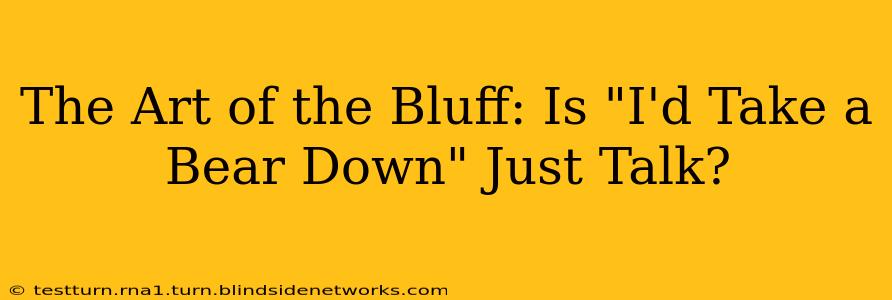The Art of the Bluff: Is "I'd Take a Bear Down" Just Talk?
We've all heard it—the bravado, the boasts, the outright bluster. Someone throws down the gauntlet, declaring, "I'd take a bear down!" But is it genuine grit, or just a carefully constructed bluff, a verbal smokescreen designed to intimidate? The answer, like the wild untamed wilderness itself, is complex. It's a fascinating blend of psychology, survival instincts, and a healthy dose of… well, let's call it "creative exaggeration."
This isn't just about macho posturing. Understanding the art of the bluff, whether it's a boast about bear-wrestling or a more subtle business negotiation, requires digging deeper than the surface-level bravado. It's about recognizing the signals, understanding the motivations, and knowing when to call the bluff—or when to bluff yourself.
What Makes a Bluff Effective?
A successful bluff relies on a carefully orchestrated performance. It’s not about brute force, but about projecting an image of confidence and capability that surpasses reality. This involves several key elements:
-
Confidence: The delivery is paramount. A shaky voice, nervous fidgeting, or hesitant language will instantly undermine any bluff. A convincing bluff demands unwavering conviction, even if that conviction is entirely fabricated.
-
Commitment: A committed bluff is harder to call. If someone doubles down on their claim, providing further details or escalating the situation, it becomes more difficult to believe they're bluffing.
-
Ambiguity: Leaving room for interpretation allows the bluff to persist. A vague threat, an ambiguous boast—these leave enough doubt to make the opponent hesitate. Specificity, on the other hand, makes the bluff easier to challenge.
-
Audience Awareness: A seasoned bluffer knows their audience. They tailor their approach to exploit the opponent’s weaknesses, fears, and expectations.
Is "I'd Take a Bear Down" Realistic?
Let's address the bear in the room (pun intended!). The statement "I'd take a bear down" is almost certainly a bluff, at least in the vast majority of cases. While some individuals with exceptional training and experience in dealing with bears might have a higher chance of survival in a conflict, a spontaneous encounter with a bear is a life-threatening situation for almost anyone. Taking down a bear implies a level of control and dominance rarely achievable without significant risk of severe injury or death.
Why Do People Bluff?
Bluffing serves multiple purposes, both conscious and subconscious:
-
Intimidation: The most obvious purpose is to deter opponents, to make them believe they are facing a more formidable adversary than is actually the case.
-
Self-preservation: Sometimes, bluffing is a survival mechanism. In a conflict situation, projecting strength might be a way to avoid a confrontation altogether.
-
Social Status: Bluffing can be a way to bolster one's reputation and social standing, to project an image of competence and dominance.
-
Concealing Weakness: Bluffing can mask insecurity or lack of experience. It allows individuals to avoid admitting their limitations.
How to Spot a Bluff
Recognizing a bluff requires keen observation and critical thinking. Look for inconsistencies in the person's behavior, their body language, and their narrative. Are they overly confident? Do their claims lack specific detail? Are they avoiding direct answers to questions? These can all be indicators of a bluff.
The Art of Calling a Bluff
Calling a bluff is a risky maneuver. It requires a confident assessment of the situation and a willingness to potentially face the consequences of being wrong. The best approach often involves carefully probing for further information, looking for weaknesses in the bluff, and gauging the opponent's reaction.
In conclusion, the statement "I'd take a bear down" is, in most contexts, a testament to the power of the bluff—a captivating blend of bravado and strategic misdirection. Understanding the psychology behind such boasts is key to navigating the complexities of human interaction, both in the metaphorical and literal wilderness. The next time you hear a particularly bold claim, remember the art of the bluff and consider the unspoken truths hidden beneath the surface.

